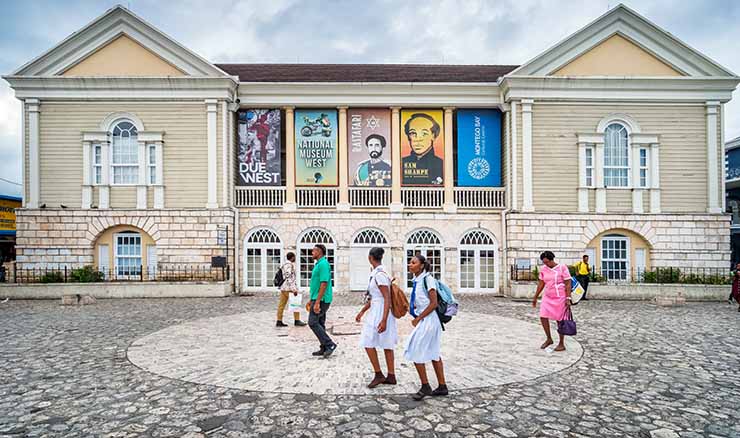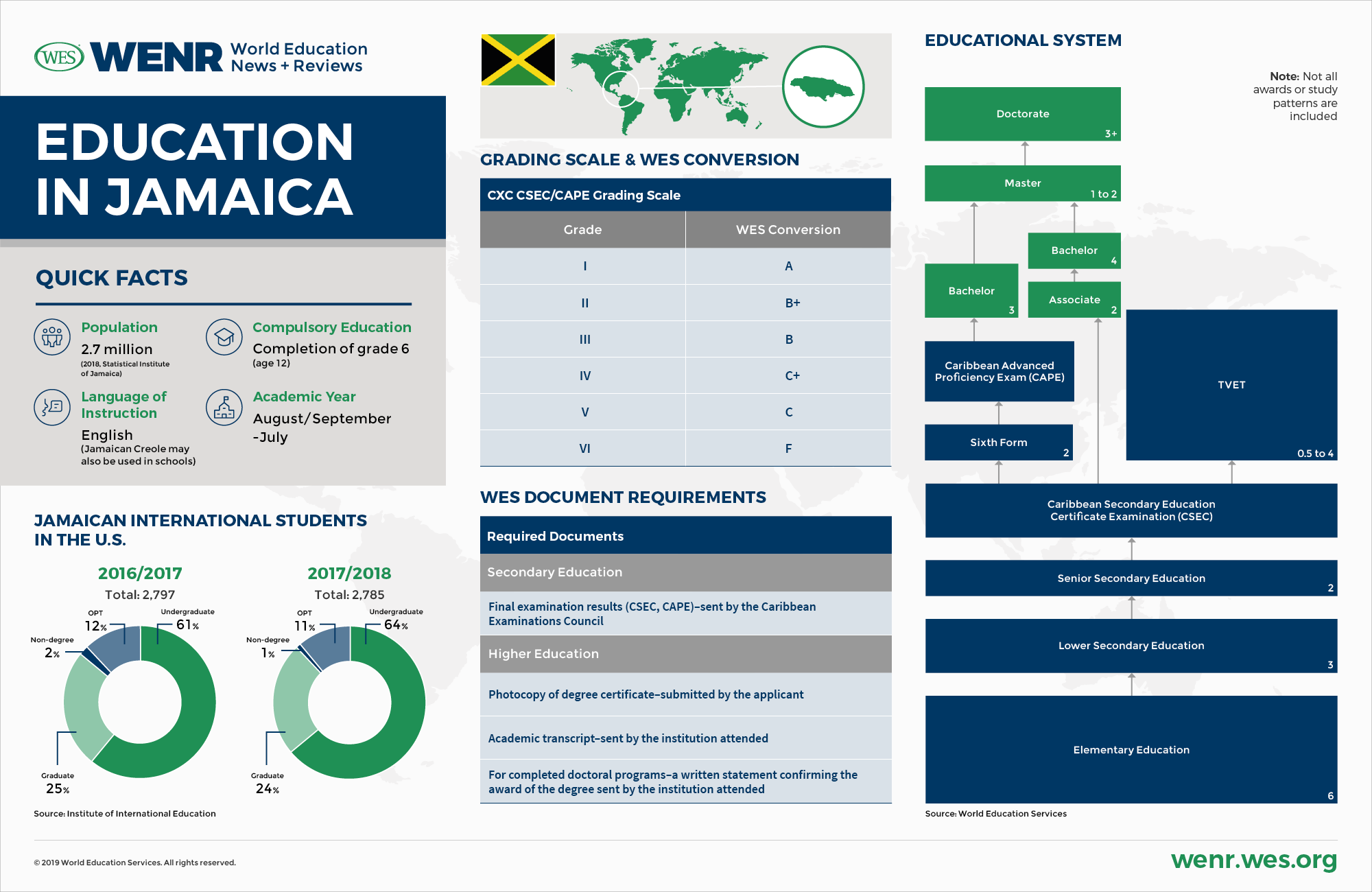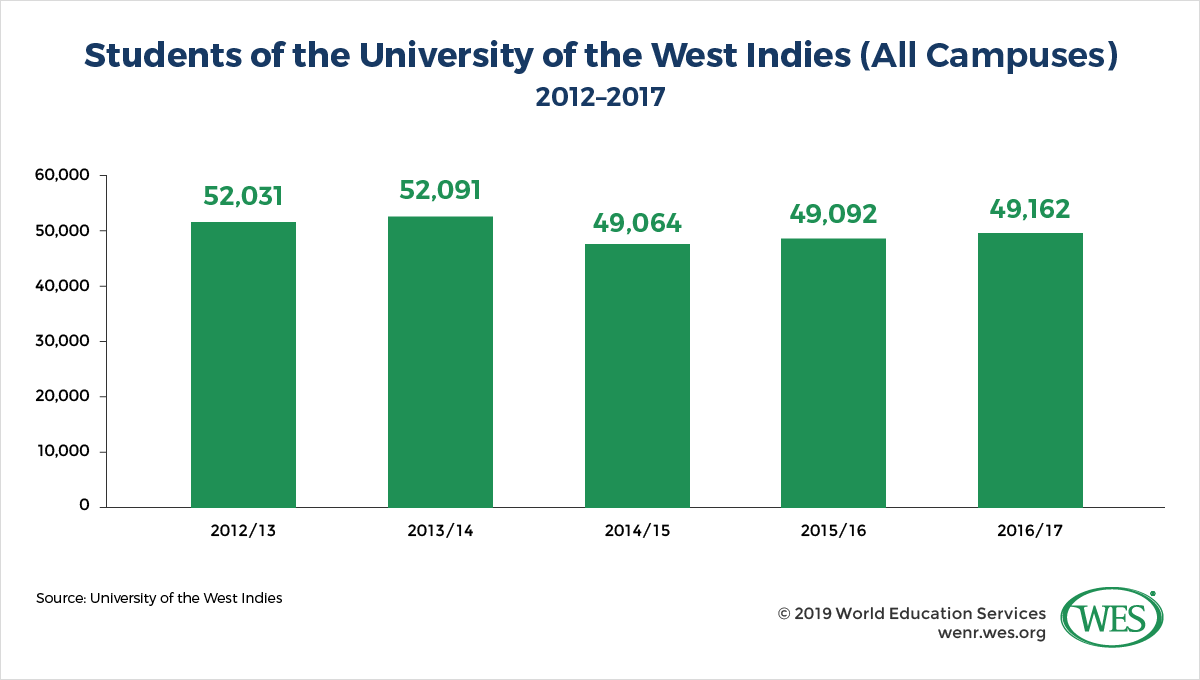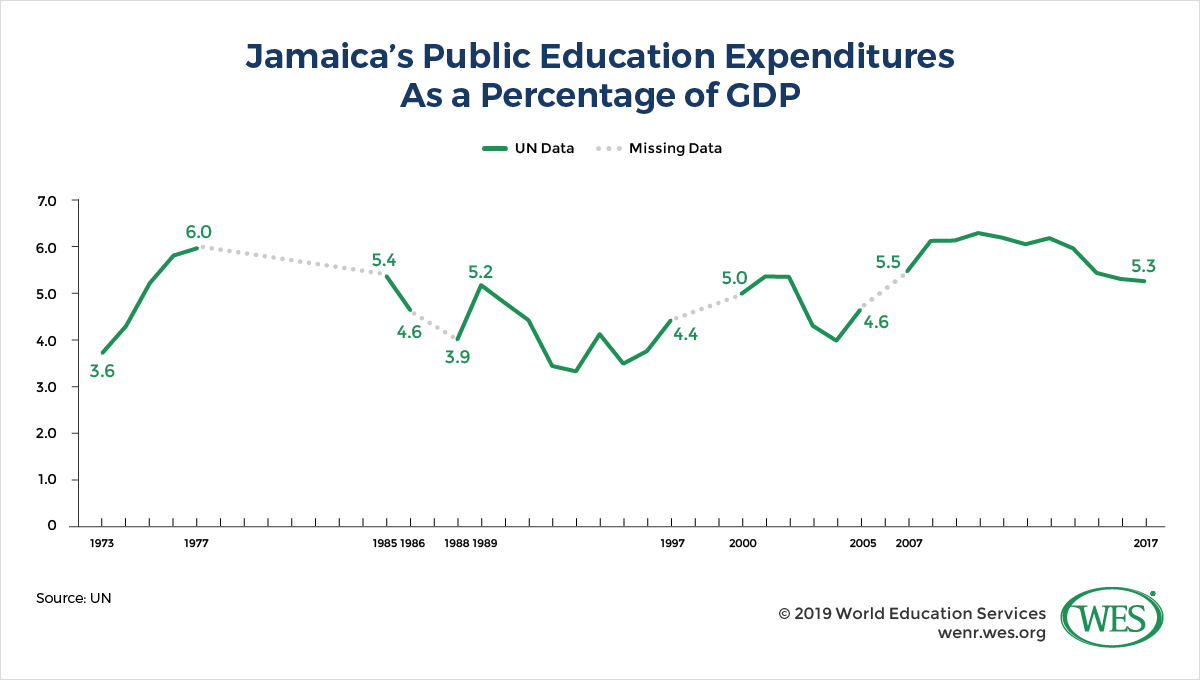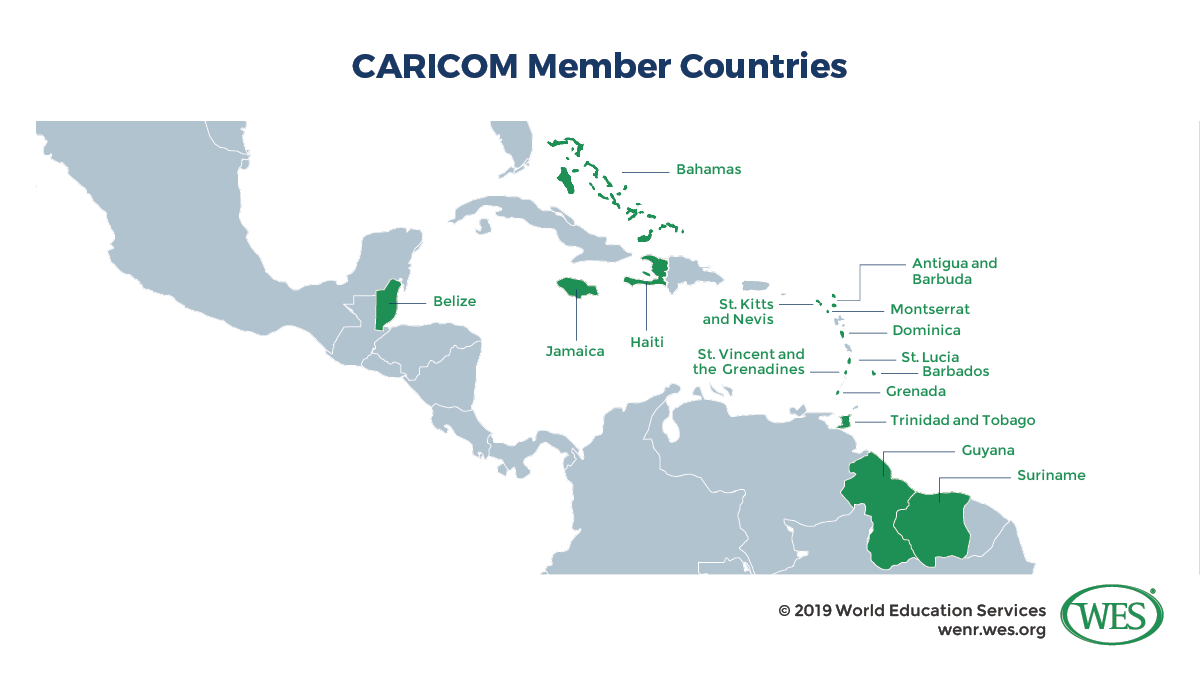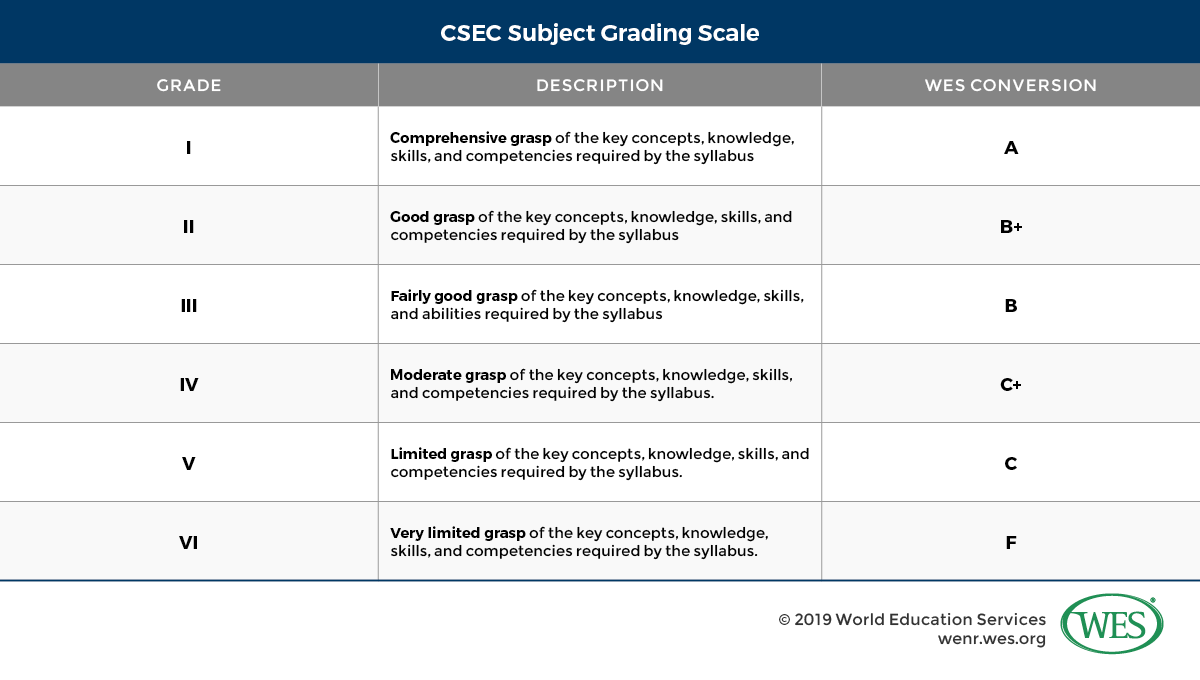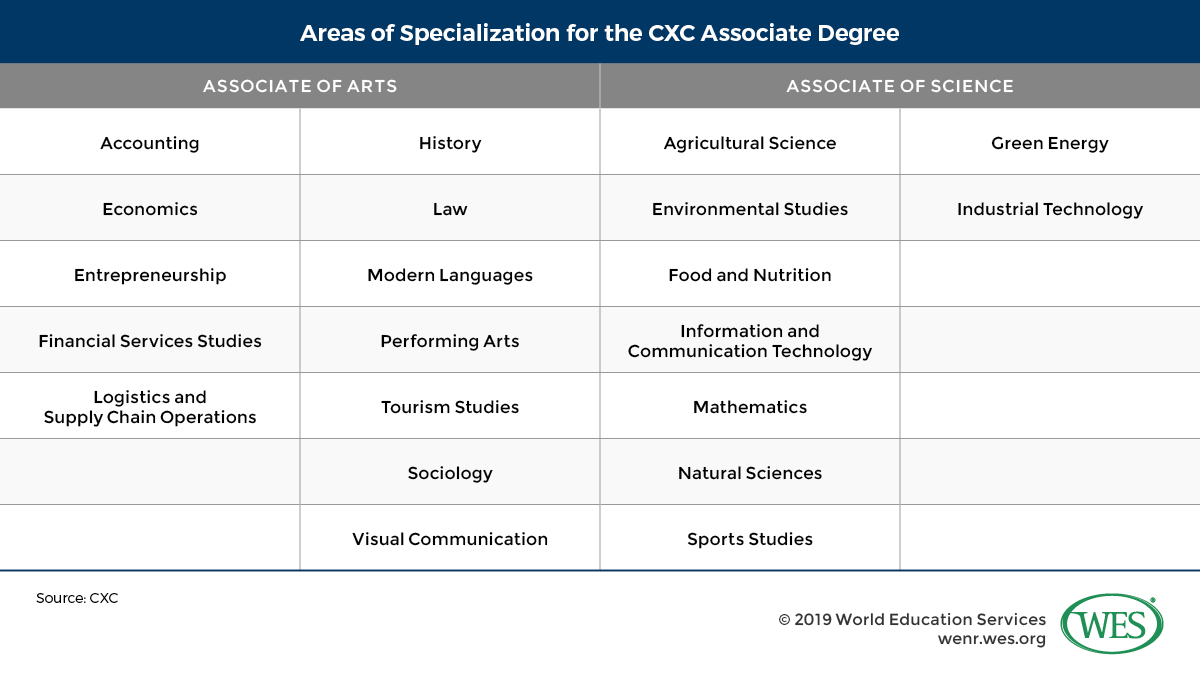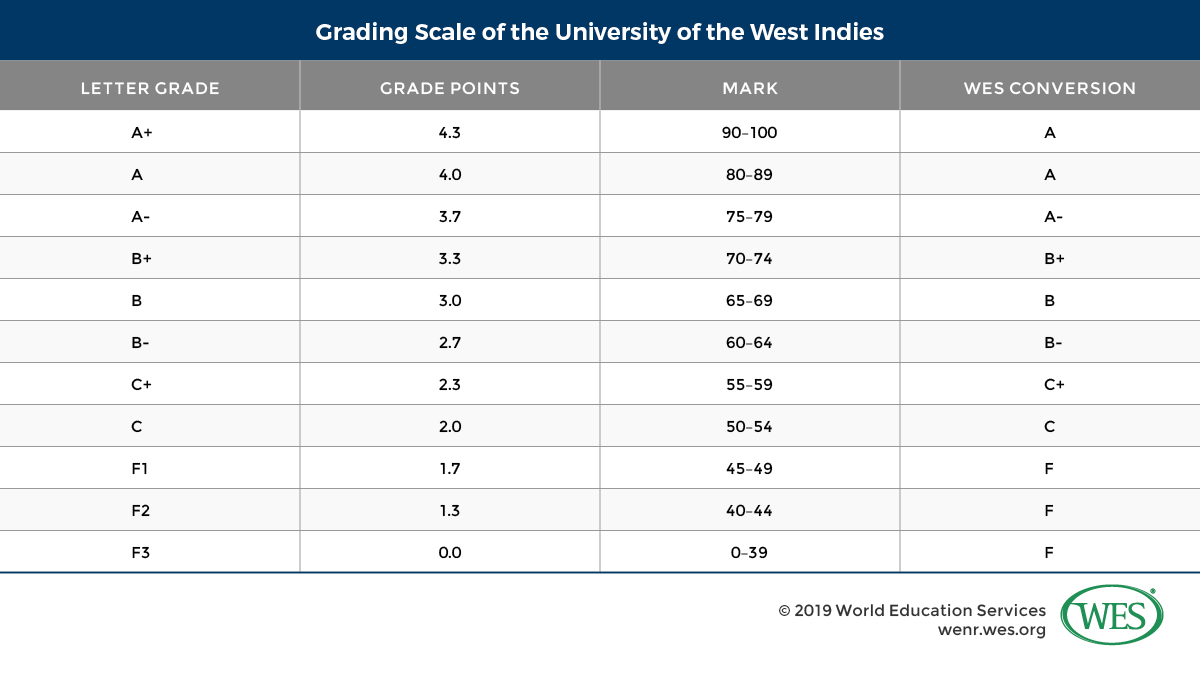Education in Jamaica
Stefan Trines, Research Editor, WENR
Introduction
As a former British colony, Jamaica is the third-largest English-speaking country in the Americas after the United States and Canada. Since its independence in 1962, the Caribbean island nation of 2.7 million people has diversified its economy from agricultural extraction to one that is more mixed, in which service industries like tourism and finance play an increasingly important role. Yet, Jamaica remains the poorest country in the Caribbean after Haiti.
As the Economist noted on the 50th anniversary of Jamaica’s independence in 2012, some of the island’s economic problems are homegrown: The country “has run fiscal deficits in 44 of its 50 years of independence. Few people pay taxes: the middle class is small, the informal economy big, and enforcement chilled-out. … The government has steadily dished out waivers to favored industries: tourism pays an effective tax rate of [only] 5%.”
However, while sluggish economic growth and high levels of debt are not uncommon in Caribbean countries, Jamaica has endured perhaps the most crippling external constraints. The country has over the past decades accrued tremendous sovereign debt, and the International Monetary Fund (IMF) subjected it to harsh structural adjustment programs. The heavy-handed measures included radically slashed government spending, wage cuts, and the mass privatization of state assets in order to downsize Jamaica’s public sector. Under the guidance of the IMF, foreign capital flooded Jamaica to the detriment of local industries, while the devaluation of Jamaican currency made goods more expensive for the Jamaican people. In 2015, Jamaica was said to have the most austere government budget in the world.
Because of this fiscal austerity, the Jamaican government has only limited resources to invest in the island’s education system. Education in Jamaica is comparatively expensive and characterized by low participation rates in secondary and higher education. Children drop out of high school in large numbers to work, or because of poverty-related problems like a “lack of lunch money” or the “inability to afford transportation costs,” according to Jamaican authorities.
Although secondary education is technically free, the costs of attending secondary school are considerable, especially for low-income households. Parents have to pay hundreds of dollars each school year for items like uniforms, teaching materials, registration fees, examination fees, and school maintenance fees. Auxiliary school maintenance fees at public schools alone amounted to roughly USD$300 per year in 2015, in a country that had a per capita gross domestic product (GDP) of USD$5,355 (in 2018).
The Jamaican government has since increased funding for secondary education and outlawed mandatory school fees in order to increase the country’s depressed secondary school enrollments. Yet, it remains to be seen if these measures can boost participation rates amid prevailing wealth disparities, low wages, and high unemployment, particularly in the impoverished rural regions of western Jamaica.
While participation in elementary education is nearly universal with a net enrollment rate (NER) of 97 percent, in upper-secondary education the NER stood at merely 60 percent in 2017 (per UNESCO statistics). As former education minister and current prime minister Andrew Holness lamented in 2011, while “Trinidad is having one tertiary graduate per household, Jamaica is still struggling to produce one high school graduate per household. Jamaica has a far way to go.”
The gross enrollment ratio (GER) in tertiary education, likewise, reached only 27 percent as of 2015 (UNESCO), a circumstance that helps perpetuate the country’s chronic shortage of university-educated professionals who are needed to build a modern knowledge economy on the island. This problem is exacerbated by an exceptionally high degree of brain drain from Jamaica, particularly among women. Almost one-third of all Jamaican women who have a college education or higher are said to have left the country for the U.S., Canada, the United Kingdom, and other destinations, many of them working as nurses or in other health professions. By some estimates, there are now more Jamaicans living abroad than on the island. Remittances from Jamaicans living overseas currently make up close to 17 percent of the country’s GDP.
International Student Mobility
Most Jamaican emigrants are younger, so it’s not surprising that Jamaica—like other small island nations—has a high outbound student mobility ratio. Close to 6 percent of the country’s tertiary students studied abroad in 2015, compared with only slightly more than 1 percent in Latin America and the Caribbean at large, per UNESCO data.
That said, the total number of Jamaican students enrolled in degree programs overseas has declined substantially in recent years. There were 4,594 Jamaican degree students overseas in 2017 compared with 7,167 in the peak year of 2004. This trend corresponds to slowing population growth and a shrinking youth population. Birth rates are falling; the percentage of Jamaica’s population under the age of 14 declined from 33 percent in 1997 to 23 percent in 2018. In the long term, Jamaica’s population is projected to eventually fall to under 2 million because of aging.
Not surprisingly, most Jamaican international students are enrolled in the U.S. and Canada, both English-speaking destinations in close geographical proximity. According to UNESCO, 2,699 students—or 59 percent of all Jamaicans seeking degrees—were enrolled in U.S. institutions in 2017.
Open Doors data of the Institute of International Education (IIE) reflect the general downward trend in Jamaican outbound student mobility. Though Jamaica is still the leading sending country of international students to the U.S. from the Caribbean—ahead of the Dominican Republic and the Bahamas—the total number of Jamaican students in the U.S. has declined by more than 40 percent over the past 15 years, going from 4,994 in 2003/2004 to 2,785 in 2017/18, according to IIE. Most Jamaican students (64 percent) are enrolled at the undergraduate level, while 24.5 percent study at the graduate level; 1 percent are in non-degree programs, and 11 percent pursue Optional Practical Training.
In contrast to the declining numbers of students in the U.S., Jamaican enrollment in Canadian institutions has surged over the past decade—from 640 in 2008 to 2,530 in 2018, as per the Canadian government. Given the high degree of labor migration from Jamaica, it’s likely that Canada’s recent expansion of post-study work opportunities and immigration pathways for international students has made Canada increasingly attractive to Jamaican students.
The U.K. is the only other country that hosts significant numbers of Jamaican students, likely because of the colonial ties between the two Commonwealth nations and the fact that it’s English-speaking. Cost may also be a factor. As Nicole McLaren Campbell of the Jamaican consultancy agency AIM Educational Services told Jamaican news media, most Jamaican “undergraduate students tend to select the U.S. because they are the most generous in financial aid for foreign students. However, a lot of master’s-level students who come to AIM are looking to the U.K. and Canada just because it’s cheaper and there is a lot more funding actually at the graduate level in the U.K. than at the undergraduate level.”
Yet, the total number of Jamaican degree-seeking students in the U.K. is small with only 201 students in 2016 (UNESCO). Observers also predict that recent restrictions on post-study work opportunities in the U.K. will make the country a less attractive destination for Jamaicans in the future.
There’s no public data available on international students in Jamaica, but the small island nation is generally not a destination for students from other world regions. There is, however, a certain degree of intraregional student mobility within the university system of the University of the West Indies (UWI), which serves students from 17 Commonwealth Caribbean countries and territories. The fact that UWI maintains campuses in different countries, however, limits the number of students going to Jamaica.
It should be noted, though, that UWI is underfunded and looking to attract more “high paying” international students to increase its revenues. The institution is increasingly focused on expanding its research activities and has a variety of cooperation and exchange agreements with overseas universities. There were 1,171 U.S. students enrolled in study abroad programs in Jamaica in 2016/17, which is not an entirely insignificant number, although it pales in comparison to the number of U.S. students in other countries, particularly in Europe.
In Brief: The Education System of Jamaica
Modern education in Jamaica was first introduced in the early 18th century during British colonial rule. Initially, education was mostly a privilege of white males only—a tool to sustain Jamaica’s colonial social system in which a small white elite ruled over a population majority of agricultural workers, most of them brought from Africa as slaves. Indigenous peoples and enslaved Africans were not educated in significant numbers until Jamaica’s slave population was emancipated, in the early 19th century. In fact, it was not before the mid-20th century, when the British granted Jamaica greater self-governance, that a less segregated mass education system began to emerge on the island. In 1957, the Ministry of Education was founded, and Jamaica’s government subsequently implemented the first major education reform to introduce universal elementary education for all children between the ages of 7 and 11.1
Over the years, the government significantly expanded the school system and succeeded in raising secondary school enrollment rates to 15 percent by the late 1970s (up from 5 percent before 1953).2 However, education access continued to be heavily skewed toward higher income households in the metropolitan area of the country’s capital, Kingston.
Alongside the growth of the secondary school system, Jamaica’s higher education system also began to expand in earnest. Following the establishment of UWI as the first higher education institution (HEI) in the British West Indies, several other public HEIs, including community colleges and teacher training colleges, were established in Jamaica in the 1960s and 1970s. The College of Arts, Science and Technology (CAST), the predecessor of Jamaica’s University of Technology, for instance, was formally founded in 1964. The number of tertiary students subsequently shot up from 14,000 in 1981 to nearly 75,000 in 2015 (UNESCO data).
Interestingly, a clear majority of almost 63 percent of current Jamaican students are women (in 2015, per UNESCO). According to the latest 2018 Global Gender Gap Report of the World Economic Forum, 34 percent of Jamaican women enroll in higher education programs compared with only 20 percent of men. That’s one of the highest such disparities in the world.
The University of the West Indies
No account of education in Jamaica would be complete without mention of the University of the West Indies. Originally established as the University College of the West Indies in 1948 in Mona outside of Kingston, the institution was the first HEI in the British West Indies Caribbean set up to function as the intellectual center of the Commonwealth Caribbean islands and British territories in the Caribbean.
UWI is today the largest higher education institution (HEI) in the English-speaking Caribbean. It’s one of only two regional cross-country universities worldwide next to the University of the South Pacific. It has become a large university system serving students from Anguilla, Antigua and Barbuda, the Bahamas, Barbados, Belize, Bermuda, the British Virgin Islands, the Cayman Islands, Dominica, Grenada, Jamaica, Montserrat, Saint Kitts and Nevis, Saint Lucia, St. Vincent and the Grenadines, Trinidad and Tobago, and the Turks and Caicos Islands.
UWI had some 49,000 students in 2017, 18,500 of them enrolled in its main campus in Mona. In addition to the Mona campus, UWI has constituent campuses in St. Augustine in Trinidad and Tobago (also enrolling some 18,000 students) and in Cave Hill in Barbados (5,800 students). Since 2008, UWI has also had an Open Campus that delivers education to nearly 7,000 students across the islands, mostly via distance, blended, and online programs. Given the topography of the islands, online education is a cost-effective way to reach dispersed student populations throughout the Caribbean. In addition, UWI’s main campuses have several satellite campuses that provide regular face-to-face instruction.
UWI plays a crucial role in providing higher education in the English-speaking Caribbean. It has produced more Caribbean scholars than any other university. However, the institution has recently been strained by the increased demand for higher education coupled with dwindling public funding. Throughout the 2000s, UWI suffered from steeply declining financial resources; in 2010 alone, the Jamaican government slashed its funding for the Mona campus by an unprecedented 25 percent. Despite this neglect, UWI in 2019 emerged for the first time in the Times Higher Education World University Rankings at the rank of 501–600. The institution has recently diversified its funding sources and increasingly focused on research.
In the 1980s, the government-driven expansion of the education system slowed and gave way to spending cuts because of Jamaica’s growing indebtedness and IMF-imposed austerity measures. Sorely needed public assistance programs like scholarships for UWI students and subsidies for school uniforms were scrapped, while the government enacted education taxes on Jamaican incomes and reintroduced tuition fees at UWI and the University of Technology. The Jamaican government simultaneously encouraged greater private investment in higher education,3 but private higher ed providers never became dominant in Jamaica despite their growing numbers. Public HEIs continue to enroll most students today.
It should also be noted that despite the country’s financial malaise, education spending has gone up again to relatively high levels in recent years. After dropping from 6 percent of GDP in 1977 to 3 percent of GDP in 1993, public education expenditures rose again to around 6 percent of GDP by the early 2010s. Most recently, education budgets grew by 3.9 percent in the 2017/18 fiscal year and by 2.7 percent in the 2018/19 fiscal year. While past education expenditures were partially financed with tax increases, in 2018 Jamaicans weren’t asked to pay higher taxes for the first time in 14 years. Combined with a modestly optimistic outlook for Jamaica’s economy at large, this may be an encouraging sign for Jamaica’s education system.
Administration of the Education System
Education in Jamaica is centrally steered by the Ministry of Education, Youth and Information (MOE) in Kingston. However, the system is decentralized to a certain degree. To improve oversight and delivery of services, the MOE maintains six regional offices that monitor and manage education in different areas across the country. In addition, it oversees several statutory bodies and agencies. These include the National Council on Education, which nominates the members of the boards of management of more than 1,000 public schools in Jamaica, as well as the Early Childhood Commission, which supervises elementary schools and early childhood education providers. It also manages the National Education Trust, a government agency that allocates funding to Jamaican schools. The quality of the school system is monitored by the National Education Inspectorate, which inspects Jamaica’s schools and provides guidance and advice to the MOE, school boards, and administrators.
The main oversight bodies in higher education are the University Council of Jamaica (UCJ), along with the newly established Jamaica Tertiary Education Commission (J-TEC), a statutory body tasked with ensuring quality control and managing and developing the tertiary education system at large. UCJ was set up in 1987 as an external accreditation body to register and accredit diploma, certificate, and degree programs offered by the growing number of Jamaican HEIs. As such, it accredits academic institutions and individual study programs offered by public and private HEIs. UCJ accreditation is voluntary, but J-TEC is presently piloting a mandatory registration process for all HEIs. (See the section on quality assurance below.)
Language of Instruction and Academic Calendar
While Jamaica is formally considered an English-speaking country, it’s actually a bilingual nation in which English is not the native tongue. There are two languages in use on the island: standard Jamaican English and Jamaican Creole, or Patois. While Patois, an English-based Creole language with West African influences, is spoken by most Jamaicans as their native language, standard Jamaican English is formally the official language in education, according to Jamaica’s latest Language Education Policy. Patois is nevertheless widely spoken in schools, especially during the early grades. Spanish is officially designated as the primary foreign language taught in Jamaican schools. The language of instruction in higher education is standard Jamaican English.
The academic year at Jamaican schools is usually divided into three terms: A Christmas term from late September to December, an Easter term from January to April, and a summer term from April to July. UWI and other HEIs use a semester system divided into one semester from August to December and a second semester from January to May. There may also be a shorter summer semester between May and July.
Pre-Elementary and Elementary Education
Jamaica has been highly successful in ensuring access to pre-elementary early childhood education. The country was recently recognized by UNICEF as “a model for early childhood development, thanks to the results of a pioneering early childhood program and near to 100 percent enrollment in early childhood institutions (ECIs) at age 3.” Most Jamaican children attend public or private ECIs between the ages of three and five before sitting for a Grade One Individual Learning Profile (GOILP) assessment “to ascertain their capabilities and mastery of the skills and concepts taught at the Early Childhood level.”
This phase is followed by elementary education, which lasts six years (grades one to six) and is taught at public schools and private preparatory schools. During the first three years, schools follow an integrated curriculum that focuses on academic socialization, language arts, basic mathematics, and other subjects. The curriculum is expanded and diversified in grades four to six; it includes the arts, language arts, mathematics, music, physical education, religion, science, and social studies.
There are a number of competency assessments throughout the elementary cycle, such as the Grade Four Literacy Test and Grade Four Numeracy Test. While pupils’ performance on these tests has improved markedly over the past decades, learning outcomes in 2012 remained suboptimal with around 50 percent of fourth graders demonstrating mastery of numeracy skills. Pupils at private schools—mostly better-funded, high tuition-charging institutions located in Kingston—often perform better than those in public schools. In 2017, close to 9 percent of elementary students in Jamaica were enrolled in private schools.
At the end of grade six, pupils sit for an examination that determines eligibility for graduation and progression into lower secondary education. Formerly known as the Grade Six Achievement Test (GSAT), it’s been modernized and replaced with the Primary Exit Profile (PEP) as of 2019.
Often criticized for fostering rote learning at the expense of creative thinking, the GSAT tested five subjects: English, communications, mathematics, science, and social science. The new PEP exams, by contrast, are more focused on assessing competencies. They include a “performance task” in which pupils apply knowledge in real-world situations, an analytical ability test, and a standard curriculum-based exam in language arts, mathematics, science, and social studies.
Exam results may affect which schools students are placed in. Each graduate of grade six can apply to seven different high schools (or the secondary departments of combined all-age schools). In 2018, 80 percent of GSAT takers were admitted to a school of their choice. After the implementation of the new PEP exam, that percentage went up—of the 42,000 pupils that sat for the exam in 2019, 94 percent were admitted to a school of their choosing—even though some 40 percent had failed to demonstrate minimum proficiency.
Lower-Secondary Education
Secondary education in Jamaica is not compulsory, although deliberations are under way to make it so in the future for all children under 18. Secondary education is divided into a lower-secondary (junior secondary) phase that encompasses grades seven to nine (also called forms one to three), followed by an upper or senior-secondary phase in grades 10 and 11 (forms four and five).
A nationwide lower-secondary core curriculum was adopted in the 1990s in the “Reform of Secondary Education” (ROSE) project, which sought to standardize Jamaica’s hitherto rather diversified junior secondary education system. The new standardized curriculum included general academic subjects—language arts, mathematics, science, the social sciences, and a foreign language (Spanish)—in addition to vocationally oriented subjects such as “career guidance” and “resources and technology,” as well as artistic subjects like drama and dance.
However, the MOE is currently implementing yet another National Standards Curriculum (NSC) for grades one to nine. Among the changes are a greater emphasis on “21st century skills” and learner-centric teaching, as well as the introduction of subjects like foreign language during elementary school. To reduce dropout rates, there will be three different “Alternative Pathways to Secondary Education” (APSE) available at the end of grade six. Instruction in the APSEs “will be based on tailored curricula, enabling each learner to perform to his/her fullest potential, based on aptitude, interest and ability”: “Pathway one will facilitate students who can access the secondary school curriculum with little or no support; Pathway two will be for those students who need more support, while Pathway three is for students who require much support for them to adequately access secondary education.”
There are currently no external examinations at the end of lower-secondary education. The Caribbean Examinations Council (CXC) had offered an exam—the Caribbean Certificate of Secondary Level Competence (CCSLC)—since 2007, to certify lower-secondary competencies and knowledge at the end of grade nine, but its use in Jamaica was suspended in 2011.
Upper-Secondary Education
Upper-secondary education (grades 10 and 11), on the other hand, is designed to prepare students for the external Caribbean Secondary Education Certificate (CSEC) examinations conducted by the CXC. The system is closely patterned after the British model. All students must study core subjects like mathematics and English, but they simultaneously study between six and ten elective subjects that they intend to sit for in the CSEC exams.
Students that fail all CSEC subjects but otherwise meet the school requirements for completion of grade 11 may be awarded a high school graduation certificate. However, Jamaican employers and HEIs typically expect to see passing scores in at least five CSEC subjects, and most students sit for at least seven subjects. The MOE is currently introducing a National School Leaving Certificate as a new benchmark qualification for entry-level employment. It’s expected that the new certificate will require fewer than five CSEC passes.
While the CSEC exams mark the end of secondary education, students who wish to advance to tertiary education may study for an additional two years in grades 12 and 13 (commonly referred to as lower and upper sixth form) to prepare for the Caribbean Advanced Proficiency Exam (CAPE), a challenging exam that may be required—in addition to CSEC exams—for admission into bachelor’s programs at some HEIs. Sixth form programs are only run by select high schools and colleges. They are usually expensive and hard to get into. Applicants must have high scores in a minimum number of CSEC subjects.
There’s also an alternative pathway at some schools that gives students between the ages of 16 and 18 who did not pass any CSEC subjects the chance to complete a two-year “Career Advancement Programme” (CAP) in order to qualify for post-secondary vocational education and training.
The Caribbean Examinations Council (CXC)
Established in 1972, the CXC is a regional examining body and an institution of the Caribbean Community (CARICOM) that administers examinations in 16 countries and territories: Anguilla, Antigua and Barbuda, Barbados, Belize, British Virgin Islands, the Cayman Islands, Dominica, Grenada, Guyana, Jamaica, Montserrat, Saint Kitts and Nevis, Saint Lucia, Saint Vincent and the Grenadines, Trinidad and Tobago, and the Turks and Caicos Islands. In addition, students from the non-member territories of Saba, Sint Maarten, and Suriname—all part of the Kingdom of the Netherlands—may also sit for CXC exams.
The Council comprises the vice chancellors of the University of the West Indies and the University of Guyana, as well as representatives of the governments of the member countries and other university representatives. Its main administrative offices are in Barbados and Jamaica.
CXC examinations have replaced the former British General Certificate of Education (GCE), Ordinary examinations in the 1970s, as well as the GCE, Advanced level exams in the 1990s.
The Caribbean Secondary Education Certificate (CSEC)
The CSEC serves as the de facto upper-secondary school-leaving qualification in the 16 CXC member states and territories. Students in grade 11 at public secondary schools, as well as students at private high schools and non-school affiliated (private) candidates are eligible to sit for the exams. In Jamaica, the Overseas Examinations Commission (OEC) administers the exams at public high schools, which usually register their students automatically. Private candidates, on the other hand, sit for the exams at dedicated examination centers. School candidates usually sit for the exams in June but may re-sit them the following January when private candidates take the exams.
The CXC presently offers examinations in 33 subjects. Some of the subjects are more career-oriented, “technical proficiency subjects,” like industrial technology or technical drawing, but most are general proficiency subjects preparing students for further education, such as Caribbean history, chemistry, geography, foreign languages, physics, or theater arts. Mathematics and English are compulsory subjects.
In most subjects, the final CSEC score represents a combination of external examinations and an internal School Based Assessment, both based on CXC syllabi. Depending on the subject, the exams include multiple-choice questions, written essay questions, practical tests, and oral examinations (in language subjects). Since 2017, students have had the option of taking the multiple-choice components of the exams electronically. Independent candidates may be allowed to substitute School Based Assessments in certain subjects by taking additional exams (known as “alternative papers”).
Subjects are graded on a 6-point scale using Roman numerals, although it should be noted there’s also an A-F scale used for individual subject components like CAPE units (see below). The grades are based on a student’s demonstration of certain “levels of competencies, abilities, and skills” rather than grading in relation to other students sitting for the exams. The results are usually available in two to three months and can be retrieved online. Sixty percent of the more than 63,000 students registered for the CSEC in 2018 were female; 68 percent of all subject entries passed with grades between I and III.
The Caribbean Advanced Proficiency Exam (CAPE)
As the successor of the British A Level exams in the Commonwealth Caribbean, the CAPE is designed as a two-year university-preparatory program for high school graduates. The CAPE program is intended to be a school-based program taught at sixth form colleges or community colleges, although students can sit for CAPE subjects at the same time that they sit for the CSEC exams, and independent candidates who did not attain the CSEC are free to take the CAPE as well. However, schools that teach the CAPE curriculum typically require that students pass a minimum number of CSEC exams with high grades. Over 86 percent of CAPE candidates in 2018 attended schools.
CAPE subjects are more modularized and afford students greater flexibility, compared with the CSEC exams. Students can study single subjects or several subjects concurrently. Most subjects include two units that are tested separately. While students generally sit for the units sequentially, it’s possible to sit for Unit 2 before Unit 1 in most subjects. Three subjects—Caribbean studies, communication studies, and integrated mathematics—consist of only one unit. Each unit is made up of three different content modules. Overall, the CXC offers examinations in 35 subjects, most of them in similar fields as those of the CSEC exams.
Like the CSEC, CAPE subject grades incorporate a school-based assessment (or alternative paper) in addition to external examinations administered by the OEC. The grading scale is the same as the one used for the CSEC.
While students who passed just a few subjects receive a certificate listing the completed units, they also have the opportunity to “accumulate” units over time to earn a higher award. Students who complete six units, including Caribbean studies, with a grade above V are awarded a CAPE Diploma, while those who pass 10 units within five years or less are awarded a CXC associate degree. The subjects Caribbean studies, communication studies, and integrated mathematics are mandatory for all associate programs. The curricula of these programs include a general education component, as well as major-specific core subjects and electives. Each unit is equivalent to 10 credits and requires approximately 150 hours of study, according to the CXC guidelines. The degrees awarded are either the Associate of Arts or Associate of Science in the specializations listed below.
Students may also get exemptions at some universities in Jamaica, other Caribbean countries, the U.S., or Canada, based on their CAPE subjects. In addition, there are a few formal articulation agreements that ensure the smooth transfer of credits in place between the CXC and overseas universities, including the State University of New York at Plattsburgh and the University of South Florida.
University Admissions
Admission criteria at Jamaican universities vary by institution and program, but five CSEC passes generally represent the minimum requirement. Some HEIs require a set number of both CSEC and CAPE subjects passed with sufficiently high grades. For example, UWI requires five CSEC subjects with grades I–III and two double Unit CAPE subjects, one of them in a major-related field, for admission into many of its bachelor programs. The Mico University College, likewise, requires a minimum of five CSEC subjects (with mathematics and English being compulsory) and two CAPE units for standard admission.
Institutions like the University of Technology or Northern Caribbean University, on the other hand, admit students into bachelor programs solely based on CSEC subjects (typically five subjects related to the intended major passed with a grade of III or higher). NCU also allows applicants who have only three CSEC passes to enroll in a one-year pre-university bridging program in which students can earn university credit while sitting for additional subjects. Associate degree programs can almost always be entered based on five CSEC subjects.
Technical and Vocational Education and Training (TVET)
Like many other countries, Jamaica is seeking to expand its TVET sector to upskill its labor force, reduce youth unemployment, and stimulate economic development—an urgent objective since “close to 70.0 percent of the labor force, or over 700,000 workers” had no formal training as of 2009, according to the Planning Institute of Jamaica.
The main institution tasked with advancing TVET is the Human Employment and Resource Training (HEART) Trust, a government agency first established in 1982. The HEART Trust offers post-secondary vocational training programs at some 20 training centers and institutes across the island and oversees the National Council on Technical and Vocational Education and Training (NCTVET), which develops national competency standards and curricula, and accredits private TVET providers.
TVET programs can be institution-based or work-based apprenticeship programs. Formal programs can be between six months and four years in length and usually lead to the award of the National Vocational Qualification of Jamaica (NVQ-J), a certificate of competence that is recognized not only in Jamaica but also in the other CARICOM and Commonwealth Caribbean countries. NVQ-Js are awarded at five different levels, which correspond to a regional qualifications framework agreed upon by the CARICOM governments. Whereas level one is an entry-level qualification, levels four and five are pegged at the level of an associate and bachelor’s degree, respectively.
- Level 1 — Directly Supervised Worker
- Level 2 — Supervised Skilled Worker
- Level 3 — Independent/Autonomous, Skilled Worker
- Level 4 — Supervisory, Specialist Worker
- Level 5 — Managerial, Professional Worker
The basic admission requirements for these programs depend on their level; they range from one CSEC subject for level 1 certificate programs to five CSEC subjects for level 5 bachelor programs at HEART Trust institutions. Depending on the program, these requirements may be substituted with diagnostic assessments or proof of work experience in the case of adult students.
The vast majority of programs are offered at levels 1 to 3 with the number of level 5 programs being small thus far. They are offered in hundreds of vocations, ranging from accounting administrator (level 4) to audio engineer (level 2), baker (level 2), diver (level 1), procurement manager (level 5), vegetable crop producer (level 2), or welding technician (level 2). More than 66,000 students were enrolled in TVET programs in early 2017, according to HEART’s latest annual report.
Higher Education Institutions
Following the shift of Jamaica’s education system from an elitist to a more participatory system over the past decades, Jamaican HEIs have grown in number and diversity. While UWI remains the preeminent HEI in Jamaica and the Caribbean at large, it struggles to accommodate mass demand in the region, especially given its financial constraints—a gap that has been increasingly filled by smaller private providers. There are now more than 50 HEIs operating on the island, many of them private.
As education researcher Chad O. Coates has noted, private HEIs “have distinguished themselves by… catering predominantly to part-time students, most of whom are employed full time; establishing academic centers within rural communities; offering flexible course schedules; and providing flexible payment options (e.g., tuition discounts, monthly and pay as you go plans).” While these institutions have helped absorb demand and spurred the growth of private enrollments, 60 percent of tertiary students still attended public universities as of 2015. UWI’s Mona campus by Kingston alone enrolls some 24 percent of Jamaican students.
While UWI is the undisputed center of academic research in Jamaica, there are a number of other multi-faculty universities in Jamaica like the public University of Technology, or the private, religiously affiliated International University of the Caribbean and the Northern Caribbean University. The University of the Commonwealth Caribbean is said to be Jamaica’s largest private university with six campuses and some 5,000 students. There are also 10 public community colleges which have various satellite campuses across the island overseen by the Council of Community Colleges of Jamaica. In addition, there are several teacher training colleges and various private colleges, as well as specialized HEIs like the Caribbean Maritime University or the Edna Manley College of the Visual and Performing Arts.
Quality Assurance and Accreditation
One recent change in quality assurance in Jamaican higher education is a requirement that all HEIs that offer education programs will have to first register with the Jamaica Tertiary Education Commission (J-TEC). This mandatory registration process is currently being tested in a pilot phase with six HEIs. To obtain J-TEC registration, HEIs must have a valid business license, adequate facilities, teaching staff, financial resources, administrative structures, and learning resources. Compliance with these criteria is certified via site visits by J-TEC education inspectors. Successful institutions receive a certificate of registration that is valid for a period of five years. It is presently unclear when this new process will be rolled out for all HEIs in Jamaica.
The planned changes notwithstanding, the accreditation of academic institutions and programs by the University Council of Jamaica is expected to remain voluntary. To obtain accreditation, HEIs must first register with the UCJ based on criteria similar to those stipulated by the J-TEC. Registered institutions then have four years to seek accreditation of their study programs, which is granted upon the evaluation and peer review of institutional self-assessments and UCJ site inspections. Initial accreditation is granted for four years, whereas renewed accreditation is granted for five years. In 2017, the UCJ accredited or re-accredited 67 academic programs, including 16 associate degree programs, 29 bachelor’s programs, 12 master’s programs, and other diploma and postgraduate diploma programs. The UCJ maintains an online directory of accredited programs.
HEIs that obtain institutional accreditation, on the other hand, don’t have to submit their individual study programs for evaluation. Their accreditation is contingent on their having robust internal quality assurance mechanisms in place. Compliance is assessed via site inspections and continually monitored. HEIs must submit “annual status reports and a mid-cycle review is undertaken during the period of accreditation.” There are presently only three HEIs that have institutional accreditation: UWI, the University of Technology, and—since 2019—the Northern Caribbean University, Jamaica’s oldest private HEI, which is affiliated with the Seventh-day Adventist Church. Four additional HEIs have applied for institutional accreditation and currently have candidacy status.
The UCJ also accredits or recognizes a number of programs taught in Jamaica transnationally by overseas institutions. These include the Ohio State University, Temple University, and the British Heriot-Watt University.
Grading Scales and Credit System
While there are no mandatory nationwide grading scale or credit systems in Jamaica, the system is fairly standardized with most HEIs using U.S.-style credit systems and variations of A to F letter grading scales (although numerical scales 0-100 are also used). UWI uses the grading scale shown below. A grade of C (50 percent) is the minimum passing grade for a course, and a cumulative GPA of 2.0 is required for the award of a bachelor’s degree. One year of study is typically quantified as 30 credit units, so that 90 credits at a minimum are required for a three-year bachelor’s program. At UWI, each course carries three or six credit units.
Certificates, Diplomas, and Associate Degrees
There are various certificate, diploma, and associate degree programs offered by several types of HEIs, including community colleges and universities. While these programs are hard to generalize, they are usually entered based on the CSEC and last between six months and three years, with most associate programs being two years in length. Depending on the program and institution, holders of associate degrees or diplomas may be granted exemptions in bachelor’s programs. The Council of Community Colleges of Jamaica, for instance, has a structured 2+2 degree system in which students earn an associate degree after two years and a bachelor’s degree in a related discipline after another two years of study.
Associate programs usually include a general education component, major-specific courses and electives, as well as an internship in some cases. Students must earn a set number of credit units before progressing to the next year. Credentials awarded include the Associate of Arts, Associate of Science, and Associate of Applied Science degree.
Bachelor’s Degree
Some exceptions notwithstanding, there are two main variations of bachelor’s programs in Jamaica. Most bachelor’s degree programs at UWI are patterned after the British model and require three years of study following the completion of an A Level/CAPE program (13+3). However, other HEIs offer programs that are open to CSEC graduates and require four years of study, including a preliminary year consisting of introductory subjects (12+4).
Aside from a small general education component, bachelor’s programs are usually specialized in the major field of study. Some programs include a thesis, research project, or practicum, but others do not. Programs may be offered in regular full-time and part-time mode. Credentials awarded include the Bachelor of Arts, Bachelor of Science, and Bachelor of Business Administration.
Postgraduate Diploma
A postgraduate diploma is typically a one-year graduate program intended for further specialization in professionally oriented disciplines. The Postgraduate Diploma in education is an entry-to-practice qualification for aspiring teachers (see below).
Master’s Degree
Master’s programs are between one and two years in length. They include taught coursework followed by a thesis or a research project, but programs of coursework only also exist. Admission is based on a bachelor’s degree in a related major earned with sufficiently high grades. The Master of Philosophy (MPhil) is an advanced research degree that always requires a thesis.
Doctor of Philosophy
The Doctor of Philosophy is a terminal research degree that involves the defense of a dissertation. Most programs also include an initial period of coursework. Admission requires a master’s degree or MPhil. Doctoral programs are only offered by big multidisciplinary universities like the UWI, the University of Technology or Northern Caribbean University.
Medical Education
Professional entry-to-practice degrees in medicine and dentistry are awarded after the completion of long single-tier undergraduate programs. CAPE science subjects are typically required for admission. Medical programs are five years in length, divided into a basic medical science segment and clinical studies, followed by a one-year clinical internship. The final medical credential is called the Bachelor of Medicine and Surgery. Dental programs are five years in length as well and lead to the award of the Doctor of Dental Surgery.
There’s a regional accrediting body—the Caribbean Accreditation Authority for Education in Medicine and Other Health Professions (CAAM-HP)—that was established to promote quality and ease the international recognition of medical qualifications. Graduates from UWI can register as licensed practitioners in most English-speaking Caribbean territories.
Compared with other Caribbean island nations like Saint Kitts and Nevis or Saint Lucia, Jamaica only recently became a host country for offshore medical schools. These institutions predominantly cater to U.S. and Canadian students seeking to circumvent the stringent admission requirements and high tuition costs of medical schools in their home countries. There are so many offshore schools in the Caribbean that the region is said to have the highest number of medical schools per capita worldwide. However, it was not until 2011 that one was based in Jamaica—the All American Institute of Medical Sciences (AAIMS). Another offshore school, the Caribbean School of Medical Sciences, opened in Jamaica in 2017.
Teacher Education
Until recently, schoolteachers in Jamaica were able to teach with a three-year Diploma in Teaching, but in the early 2010s the MOE stipulated that all teachers in early childhood, elementary, and secondary education must hold a Bachelor of Education (B.Ed.). The program is four years in length and includes a teaching practicum. Admission requirements vary by institution, but five CSEC subjects are required at minimum.
UWI awards B.Ed. degrees on behalf of Jamaica’s public teacher training colleges, but other institutions like the Mico University College also award education degrees. There’s an alternative pathway for university graduates to earn a teaching qualification by completing a one-year Postgraduate Diploma in Education following a bachelor’s degree in another discipline. Quality assurance is provided by the Joint Board of Teacher Education (JBTE), a regional institution located in Mona that develops syllabi and certifies teachers. JBTE comprises representatives from UWI, teacher training colleges, teachers’ associations, and the governments of Jamaica, the Bahamas, Belize, and the Turks and Caicos Islands.
WES Documentation Requirements
Secondary Education
- Final examination results (CSEC, CAPE)—sent by the Caribbean Examinations Council
Higher Education
- Photocopy of degree certificate—submitted by the applicant
- Academic transcript—sent by the institution attended
- For completed doctoral programs—a written statement confirming the award of the degree sent by the institution attended
Sample Documents
Click here for a PDF file of the academic documents referred to below.
- Caribbean Secondary Education Certificate (CSEC)
- Caribbean Advanced Proficiency Exam (CAPE)
- Associate of Science
- Bachelor of Arts (three years)
- Bachelor of Science (four years)
- Bachelor of Medicine and Bachelor of Surgery
- Postgraduate Diploma in Education
- Master of Science
- Doctor of Philosophy
1. See: Miller, Errol and Munroe, Grace-Camille: Education in Jamaica: Transformation and Reformation, in: Emel, Thomas (ed.): Education in the Commonwealth Caribbean and Netherlands Antilles, Bloomsbury Academic, 2014 pp. 221-247.
2. Ibid.
3. Ibid.
The views and opinions expressed in this article are those of the author(s) and do not necessarily reflect the official policy or position of World Education Services (WES).
